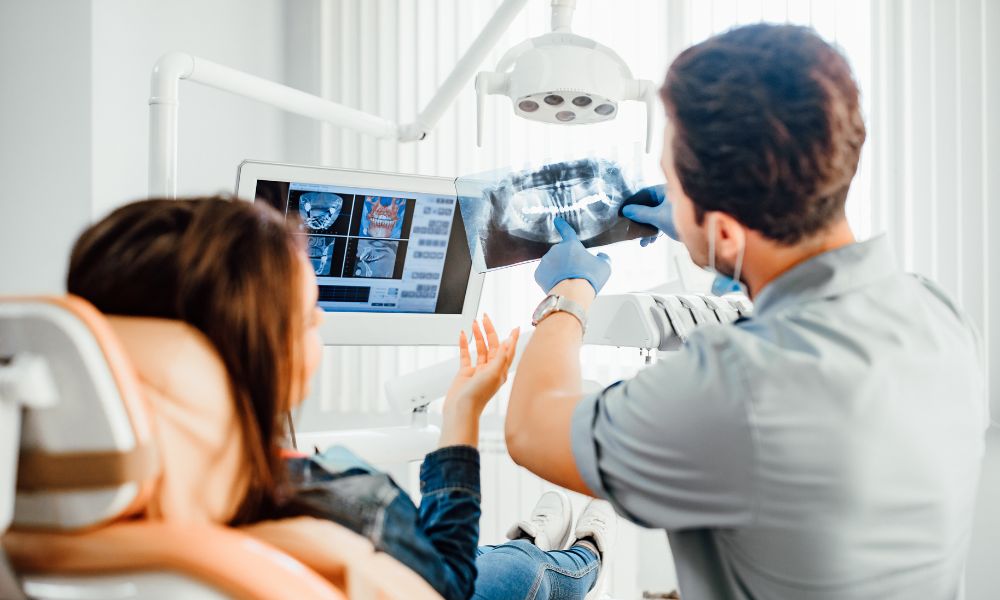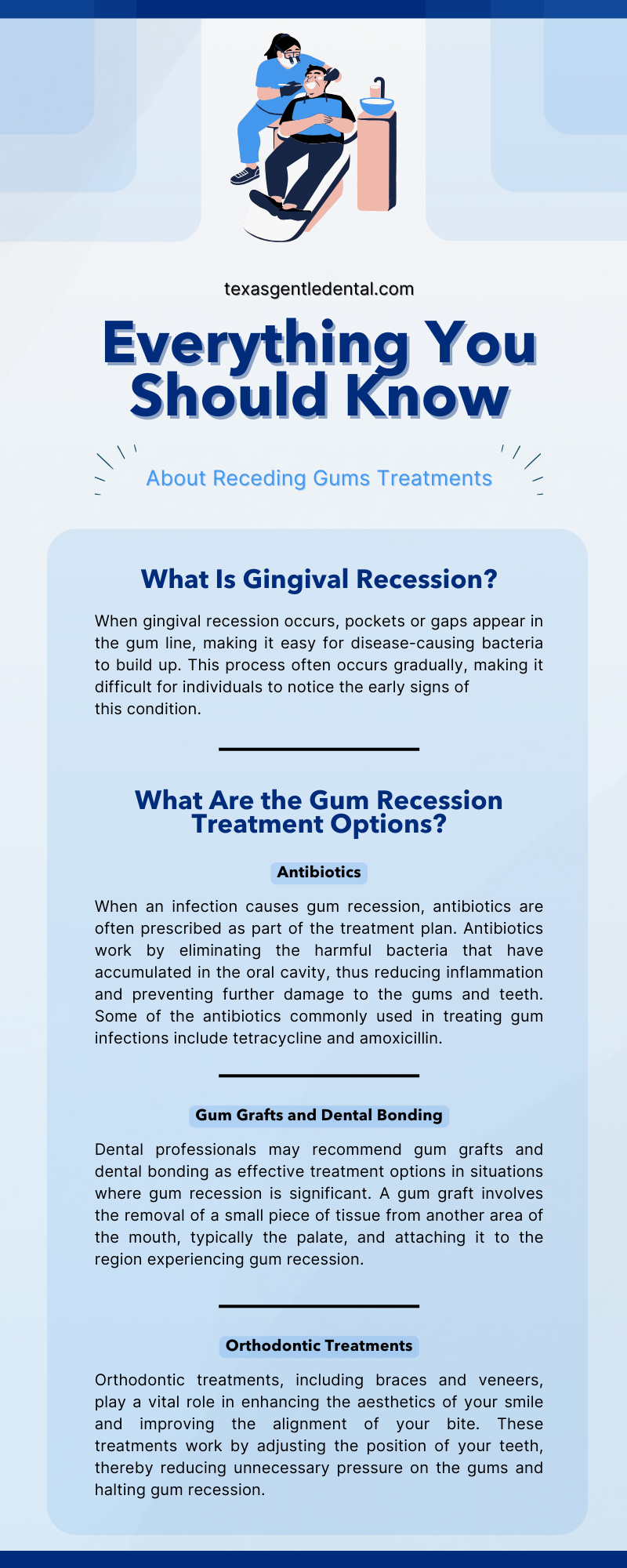Everything You Should Know About Receding Gums Treatments

Receding gums, medically known as gingival recession, refers to a condition where gum tissue around the teeth wears down, exposing the tooth or the tooth’s root. This condition is not just an aesthetic issue; it is a significant oral health concern with the potential for greater dental complications later in life.
Understanding the various treatment options for receding gums is crucial for anyone experiencing this condition. Each individual’s situation is unique, and the appropriate treatment plan varies accordingly. Treatment options are designed to either stop the progression of gum recession, protect your teeth from damage, or improve the aesthetics of your gum line. To ensure you receive the ideal medical attention, check out this guide on everything you should know about receding gums and proper treatments.
What Is Gingival Recession?
When gingival recession occurs, pockets or gaps appear in the gum line, making it easy for disease-causing bacteria to build up. This process often occurs gradually, making it difficult for individuals to notice the early signs of this condition. Additionally, many factors contribute to this acute dental complication; the most common include periodontal diseases, aggressive tooth brushing, insufficient dental care, hormonal changes, natural aging, tobacco use, and genetic predispositions.
Untreated gingival recession can have severe consequences. Most notably, the formed pockets allow bacterial buildup that damages oral tissues and bone structures. Over time, the bacteria can cause significant decay, leading to tooth loss and other health complications like heart and lung disease.
Symptoms and Signs
Recognizing the signs and symptoms of receding gums is crucial for early detection and treatment. The most apparent sign of gingival recession is tooth sensitivity. An individual may also notice a tooth appearing longer than usual, or they may experience discomfort or inflammation of the gum tissue. Others will notice changes to their gums’ color; healthy gums usually have a strong pink color, but when recession occurs, they appear red or even purplish, indicating inflammation or infection. Dental misalignment, bad breath, and notches in your gums are also common indicators of gingival recession.
How Do You Diagnose Receding Gums?
Once you suspect that you might have receding gums, scheduling an appointment with your family dentist is crucial. During this appointment, your dentist will examine your teeth and gums to determine if gum recession is indeed occurring. They may measure the depth of the pockets around your teeth using a small probe; pockets deeper than three millimeters are clear signs of recession. Your dentist will also review your medical history and discuss any symptoms or habits contributing to gum recession, such as aggressive brushing, tobacco use, or periodontal disease.
In addition to a physical examination, your dentist may use X-rays to gain a more comprehensive view of your teeth and the underlying bone structure. Impressions and 3D digital models are also great tools for visualizing the alignment of your teeth and overall bite. Combined, these tools and techniques allow for a thorough and accurate diagnosis that will help your dentist create a customized treatment plan addressing your specific needs to optimize your oral health.
What Are the Gum Recession Treatment Options?
Once you receive a gingival recession diagnosis, your dentist will discuss the most practical treatment options. Remember, not all cases of receding gums are the same—patients with minor recessions often receive restorative treatments, while those with more advanced complications are better suited for preventative or aesthetic-enhancing procedures. Ultimately, the following treatment options are prescribed based on your gingival recession’s causes and current conditions.
Antibiotics
When an infection causes gum recession, antibiotics are often prescribed as part of the treatment plan. Antibiotics work by eliminating the harmful bacteria that have accumulated in the oral cavity, thus reducing inflammation and preventing further damage to the gums and teeth. Some of the antibiotics commonly used in treating gum infections include tetracycline and amoxicillin. These medications are administered either systemically, meaning they are taken orally to reduce bacteria throughout the body, or topically, which means they are applied directly to the gums. When taken properly, antibiotics can help restore your gums to a healthy state.
Gum Grafts and Dental Bonding
Dental professionals may recommend gum grafts and dental bonding as effective treatment options in situations where gum recession is significant. A gum graft involves the removal of a small piece of tissue from another area of the mouth, typically the palate, and attaching it to the region experiencing gum recession. This procedure helps cover exposed roots, protects them from decay, and reduces sensitivity.
Dental bonding, on the other hand, involves the application of a tooth-colored resin to the teeth, which is then hardened with a special light. This not only safeguards the exposed roots but also enhances the aesthetic appearance of the teeth. Both procedures are instrumental in restoring oral health and preventing further gum recession.
Orthodontic Treatments
Orthodontic treatments, including braces and veneers, play a vital role in enhancing the aesthetics of your smile and improving the alignment of your bite. These treatments work by adjusting the position of your teeth, thereby reducing unnecessary pressure on the gums and halting gum recession. Braces and clear aligners are particularly effective in evenly distributing biting forces across all teeth, which helps prevent further gum recession. Veneers, while primarily used for aesthetic purposes, also offer some protection to the teeth and gums. However, it is crucial to note that while these orthodontic treatments mitigate the effects of gum recession and enhance your oral aesthetics, they cannot reverse or heal existing gum recession.
Of these three treatment options, gum grafts and dental bonds are undoubtedly the most long-lasting treatments. If your gum recession is severe enough, there’s a good chance you’ll need one those procedures. Orthodontic treatments are ideal for correcting any misalignment or cosmetic concerns for patients, specifically for individuals who are healing from a prior case of gingival recession. Finally, infection-caused cases of gum recession might only require a round of antibiotics and routine dental cleanings.
When it comes to everything you should know about receding gums treatments, it’s important to understand the causes, symptoms, and diagnosis processes for gum recession as well. If you’re interested in learning more about this condition and other periodontal dental services, please get in touch with our friendly team at Gentle Dental today!
